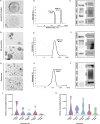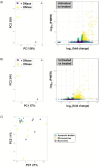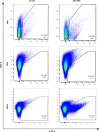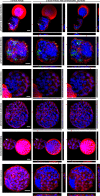Vertical transmission of maternal DNA through extracellular vesicles associates with altered embryo bioenergetics during the periconception period
- PMID: 38149847
- PMCID: PMC10752591
- DOI: 10.7554/eLife.88008
Vertical transmission of maternal DNA through extracellular vesicles associates with altered embryo bioenergetics during the periconception period
Abstract
The transmission of DNA through extracellular vesicles (EVs) represents a novel genetic material transfer mechanism that may impact genome evolution and tumorigenesis. We aimed to investigate the potential for vertical DNA transmission within maternal endometrial EVs to the pre-implantation embryo and describe any effect on embryo bioenergetics. We discovered that the human endometrium secretes all three general subtypes of EV - apoptotic bodies (ABs), microvesicles (MVs), and exosomes (EXOs) - into the human endometrial fluid (EF) within the uterine cavity. EVs become uniformly secreted into the EF during the menstrual cycle, with the proportion of different EV populations remaining constant; however, MVs contain significantly higher levels of mitochondrial (mt)DNA than ABs or EXOs. During the window of implantation, MVs contain an eleven-fold higher level of mtDNA when compared to cells-of-origin within the receptive endometrium, which possesses a lower mtDNA content and displays the upregulated expression of mitophagy-related genes. Furthermore, we demonstrate the internalization of EV-derived nuclear-encoded (n)DNA/mtDNA by trophoblast cells of murine embryos, which associates with a reduction in mitochondrial respiration and ATP production. These findings suggest that the maternal endometrium suffers a reduction in mtDNA content during the preconceptional period, that nDNA/mtDNA become packaged into secreted EVs that the embryo uptakes, and that the transfer of DNA to the embryo within EVs occurs alongside the modulation of bioenergetics during implantation.
Keywords: developmental biology; endometrium; exosomes; extracellular vesicles; human; maternal-embryonic crosstalk; medicine; metabolism; mitochondrial DNA; mouse.
© 2023, Bolumar, Moncayo-Arlandi et al.
Conflict of interest statement
DB, JM, JG, AO, IM, AM, CM, AD, PF, MC, JE, DG, CS, FV No competing interests declared
Figures












Update of
- doi: 10.1101/2023.04.21.537765
- doi: 10.7554/eLife.88008.1
- doi: 10.7554/eLife.88008.2
- doi: 10.7554/eLife.88008.3
References
MeSH terms
Substances
Grants and funding
LinkOut - more resources
Full Text Sources

